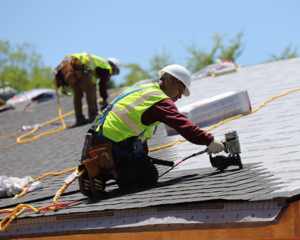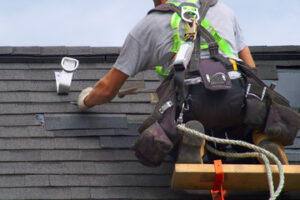Roofing is the covering that protects a home or building from the elements. There are many types and styles of roofs, from the most common asphalt shingles to premium options like real slate or composite/synthetic slate.
When choosing a roofing contractor, consider their experience. A reputable, long-time professional may charge more than a newer company, but you will likely get better results. Contact Ellingson Roofing LLC now!

Roofing is an important part of a building’s structure. It protects a home or commercial space from the elements and can improve a property’s resale value. It is made from various materials, which can affect its appearance and durability. Choosing the right roofing material for your project is important to ensure it lasts.
Among the most common roofing materials are asphalt shingles and metal. These materials are both popular for their low cost and good durability. They are available in various styles, colors, and textures. The type of roof you choose will depend on your personal preference and the climate where you live.
Wood shingles are another popular roofing material. They are typically made from redwood or cedar and have an attractive appearance that can enhance a home’s beauty. These shingles are either shingle-shaped slabs of thin veneer that have been sawed to a uniform size or split wedges that have been trimmed to a specific length. They can also be treated with a vapor retarder to prevent the transfer of water vapor from the interior of a home or building to the exterior.
Metal substrates are also gaining popularity as roofing materials. These metals can be used in various ways to create different styles of roofs, such as standing seam and corrugated. These roofs are durable and can withstand heavy loads. They can also withstand fire and have high solar reflectance and thermal emissivity ratings.
The skeleton of a roof is made from rafters or trusses. A sheathing material, such as plywood or oriented strand board (OSB), is attached to these rafters or trusses. The sheathing acts as a barrier to help prevent moisture from getting under the shingles.
Materials
Homeowners have a variety of roofing materials to choose from, each with its own lifespan and advantages. Some are more expensive, while others can withstand different weather elements. Choosing the right roof material for your home is essential for a sturdy structure that adds to the curb appeal of the property.
Asphalt shingles are one of the most popular types of roofing materials. These cost-effective shingles provide a wide range of customization options and are durable against hail, high winds, and sunlight. However, shingles can be vulnerable to mildew and moss if they are not regularly maintained.
Slate tiles are an eco-friendly option that gives homes a classic Mediterranean look. Made from natural slate, this roofing material is fire-proof and non-fading. It is also durable against water, wind, and snow. However, these tiles are quite heavy and require additional framing during installation.
Wood shingles and shakes are another traditional roofing material. These are made from various types of wood, including cedar, redwood, and southern pine. They come in wedge-shaped slabs and can be machine-made or handcrafted. They offer a natural and rustic look to the house and can last up to 50 years.
Rubber is an affordable roofing material that can be molded to mimic other materials such as slate and slate. It is also fire-resistant and can withstand a variety of weather conditions. Its only drawback is that it can give off a strong odor.
A flat roof needs a waterproof membrane that is also durable against the sun’s UV rays. EPDM membranes are a good choice for a flat roof. They are applied in large sheets to limit the number of seams that can leak. This type of roof typically lasts for 10-15 years.
A green roof is a great way to manage stormwater runoff, insulate a home, and put oxygen back into the air. This is an expensive and time-consuming option for homeowners to pursue, but it can pay off in the long run by lowering energy costs and reducing the need for landfills. It is also important to remember that a green roof requires more maintenance than other types of roofing.
Installation
The installation process of roofing is a meticulous project that requires attention to detail and expertise. Whether you are a DIYer or hiring a pro, understanding what goes into this project will help ease concerns and provide peace of mind that the job is being done right.
Once the contractor arrives to begin the work, they will start by finding access to the roof and ensuring that any equipment and materials needed are in place. They will also set up protective measures on the property. Tarps will be placed on the ground, and wooden boards will cover plants, pool areas, and anything else that could get dirty or damaged during the re-roofing process. This will keep the debris from falling and damaging these items and ensure that it can all be safely removed during the cleanup phase.
Once the tarps are in place, the roofing underlayment will be placed on top of them. This barrier material is nailed to the rafters or trusses, which are the wooden boards that form the skeleton of your roof. The first row will be nailed down close to the edge and then spread out further towards the middle. The pattern of overlapping and nailing will continue until the ridge of your roof is reached, when the underlayment will be nailed to the shingles.
Maintenance
The roof’s skeleton, referred to as the roof deck or sheathing, is made up of wooden boards, typically plywood or OSB (oriented strand board), that attach directly to rafters or trusses. Roofing underlayment is installed over the sheathing and offers a secondary barrier against moisture intrusion.
Inspecting for accumulated dirt, which clogs drains and accelerates membrane deterioration, should be conducted on a regular basis. In addition, moss, algae and other plant growth should be removed promptly to prevent damage to the underlayment. Falling tree branches and debris should be trimmed to avoid puncturing the roof and other structures, as well as blocking drainage and impairing aesthetics.
Housekeeping surveys should be conducted on most roof areas at least monthly and may need to be increased during certain periods of the year. For example, the frequency of removing vegetation from drains should be boosted in the fall when plant growth is more prevalent.
In addition to examining surface conditions, the survey should include checking stairways, crossovers and platforms for structural soundness, loose parts, safety hazards, excessive wear or signs of moisture damage. Stairways should be free of tripping hazards and obstructed steps and should be equipped with proper lighting. Signage should be posted indicating when electrical, harmful chemicals or hot equipment is present on the rooftop.
The inspection should also examine roof field membranes for evidence of physical damage and environmental deterioration. If the inspection reveals significant damage, emergency repairs should be made and permanent corrective actions should be planned for the future. Surface maintenance and some specialized inspections can be performed by building mechanics; however, extensive repairs and those covered under warranty should be contracted to qualified roofing professionals.
